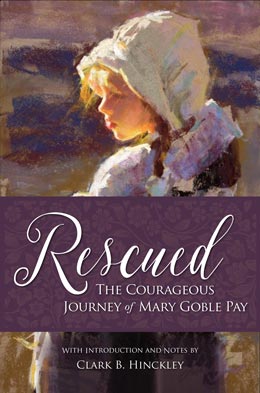Preface
I grew up hearing my parents and grandparents tell over and over the story of Mary Goble Pay’s journey across the plains. My siblings, my cousins, and I read and reread a typescript of her reminiscences. She was a heroic, almost mythical figure for us, but at the same time she was very real. Our grandfather, Phillip Leroy Pay, was Mary’s son, making our connection to our pioneer ancestor seem very close.
As we reached adulthood, we assumed the responsibility of carrying Mary’s story to the next generation. In July 1997, the sesquicentennial of the 1847 pioneer company, we chartered a bus, filled it with three generations of Mary’s descendants, and traveled the pioneer trail from Casper, Wyoming, to the mouth of Emigration Canyon in Salt Lake City. To prepare for that trip, I made for each of my siblings a copy of the first few pages of Mary Goble Pay’s autobiography, to which I added some notes to provide context and clarification to Mary’s story. That was the beginning of a project that I returned to at various times over several years and that eventually lead to this book.
Several years later my cousin, Patricia Stoker, obtained a scan of Mary’s original handwritten memoir. I was surprised to discover some significant differences between that original document and the typed versions of Mary’s autobiography in our possession. In particular, some information in our family copies was not included in Mary’s original manuscript.
As with any story told and retold, I realized that certain misconceptions had begun to surround Mary’s story. The most common of these was that Mary and her family came by handcart; she has been depicted in both painting and sculpture with “her” handcart and is often portrayed as a member of the Martin handcart company. Yet her family was part of the John A. Hunt wagon company and drove a wagon and ox team; they never pushed or pulled a handcart, though they traveled close to the handcart company and suffered with them through the cold of Wyoming.
My objectives in this book are to document the details of Mary’s trek as she described them in her handwritten memoir, place her account in the context of the story of the 1856 emigration, and verify or correct Mary’s reminiscence by correlating it with other contemporary records and reminiscences of the events of 1856. This book is not meant to be a definitive account of the 1856 companies that were caught in the winter storms in Wyoming, or even of the Hunt wagon company, of which Mary was a part; although, I have included a significant amount of information on the Hunt company since Mary’s story is inextricably intertwined with that of her fellow travelers. It is my hope that this volume will help document and preserve the experience of a thirteen-year-old girl during a few months in 1856, placing her memories of those events in a context that helps the reader better understand what she experienced.
The core of the book is a transcription of Mary’s handwritten memoir with annotations that corroborate, correct, and provide context. This annotated transcription is bookended by an introduction and epilogue that place Mary’s story of her journey in the context of her life before and after her emigration.
The remainder of the book consists of supplemental materials: a series of more extensive notes too long to be included as annotations with the text and several appendices with additional information and documents for those who want to go a little deeper. These appendices include a comparison of several versions of Mary’s autobiography, a comparative timeline of the principal emigrant companies caught in the storms in October 1856, and a complete transcript of the official camp journal of the Hunt wagon company.
I confess that I have undertaken this work largely for my own benefit, with the thought that it would also be of interest to other descendants of Mary and her family. Perhaps it also may be of some value to others with an interest in the 1856 emigration and particularly to those who may have an interest in the often-neglected Hunt wagon company.
I am indebted to many who have contributed to this work, chief among them my cousin Patricia Henrikson Stoker, who has gathered a wealth of documents and resources on Richard Pay and Mary Goble Pay; my aunts Evelyn Pay Henrikson, Doreen Pay Lloyd, and Joanne Pay Baird, who have for many years kept the story of their grandmother alive; and Christine Bowers and the Bowers family, who have carefully preserved Mary’s holograph over the years. This book is much better than it might have been as a result of the excellent suggestions and editing of many individuals at the Religious Studies Center at Brigham Young University, particularly Devan Jensen, Meghan Rollins Wilson, and Cara Nickels. And a special shout-out is due Carmen Cole, who tackled a challenging design problem with talent, skill, and panache. I give them and others their due credit for this book, but claim for myself all its shortcomings and errors.
